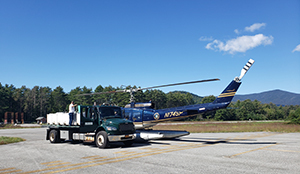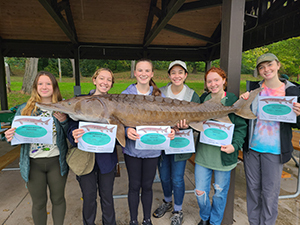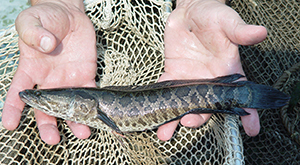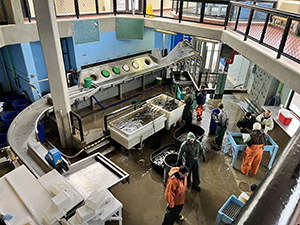The Fishing Line - October 27th Issue
The New York State Department of Environmental Conservation sent this bulletin on 10/27/2023 02:00 PM EDT |
| DEC Delivers - Information to keep you connected and informed from the NYS Department of Environmental Conservation |
| View in browser |
The Fishing Line - October 27th Issue |
Freshwater Fishing, Fisheries Management, and Fishing Access NewsIn This Issue:
When Fish Fly: 2023 Adirondack Pond Brook Trout Stocking
Last month, DEC’s Adirondack, Chateaugay, and Rome Fish Hatcheries collaborated with the NYS Police Aviation Unit to stock brook trout in remote Adirondack ponds. Air stocking has been the most efficient method of transferring fish into New York’s isolated waters since the 1930s. The process typically occurs each year in both the spring and fall for a two-week period. During this year’s fall stocking, nearly 250,000 brook trout were transported to approximately 300 ponds. Air-stocked fish were mostly fingerling-sized (1-2 inches) Temiscamie hybrids, a cross between a domestic brook trout and a wild Canadian strain, which survive best in the Adirondack’s higher acidic waters. Domestic brook trout and heritage strains of Windfall, Horn Lake, and Little Tupper made up around 30,000 of the total fish stocked. As with most stocking efforts across the state, this work serves to strike a balance between enhancing recreational angling experiences and restoring native and historical fish populations. Ultimately, the fish’s journey is an epic one. From the hatchery where they were raised, the fish are loaded onto a DEC stocking truck and transported to a landing base. Before takeoff, the fish are carefully transferred onto a NYS Police helicopter specially outfitted with pontoons, two aerated tanks, and a chute. Once the prescribed number of fish are netted into the tanks, they fly off to a designated water to be released through the chute when hovering over or landing on the water. Take a peek at a brief video on "YouTube Shorts" highlighting this year’s air stocking in the Adirondacks! Nothing Goes Together Like Kids and "Dinosaurs!"
Rain didn’t dampen the spirits of Lyncourt School students from Syracuse when they traveled to Cayuga Lake State Park this past month to learn about and help stock lake sturgeon, our resident living dinosaur! DEC Fisheries staff from Region 7 and partners from NY Sea Grant, New York State Office of Parks, Recreation and Historic Preservation, and SUNY Environmental Science and Forestry planned a full program that day. Students learned about sturgeon biology, weighed and measured live juvenile sturgeon, and then released them into Cayuga Lake. They also made fish prints and tried their hand at a bass casting game. All students received certificates commemorating their participation in sturgeon conservation. Needless to say, students and staff alike had a memorable day! "Frankenfish"
Almost as scary as Frankenstein’s Monster, northern snakehead are an invasive, predatory fish species native to Asia. Dubbed the “frankenfish,” northern snakehead can breathe air and survive for days out of water. Once established, these voracious predators have the potential to wreak havoc on an aquatic ecosystem – out-competing top predators, throwing off the balance of native fish communities and more. When it comes to identifying northern snakehead, they're commonly confused with bowfin and burbot, which are both native to New York. They are long, thin fish with a flattened head and a single dorsal (top) fin running the length of its back. They also tend to have a more pronounced blotchy pattern along their sides. Bowfin can most easily be distinguished from northern snakehead by a shorter anal fin and a rounded tail fin, while burbot have two dorsal fins and a single chin barbel. Federal and state regulations strictly prohibit the possession, sale, and transport of snakeheads in the state. How you can help:
For more information, visit the DEC northern snakehead webpage. Snakehead side-view image courtesy of Joe Perillo.
Life Jacket ReminderJust a reminder that from November 1 - May 1, everyone aboard a boat less than 21 feet (including canoes and kayaks) must wear a life jacket while underway. For more information:
Highlight Hatchery – Salmon River Fish Hatchery
Location: 2133 County Route 22, one mile north of the Village of Altmar, Oswego County. Upstream of the Beaverdam Brook and Salmon River confluence. Visitor Hours: 8:30 a.m.-3:30 p.m. daily, from April 1 through November 30. Free admission. Species Raised: Chinook salmon, coho salmon, steelhead, and brown trout Overview: The Salmon River Fish Hatchery began operations in 1980 and has played an integral role in reviving and enhancing the Lake Ontario and Lake Erie fisheries and their tributaries. The main activities that take place here are raising and stocking of:
Fun Fact: Hatchery-raised fish contribute to the salmon caught in New York’s Great Lakes, which includes more than 1.4 million Chinook salmon, 245,000 coho salmon, and 750,000 steelhead stocked annually from the Salmon River Fish Hatchery. Read: |






